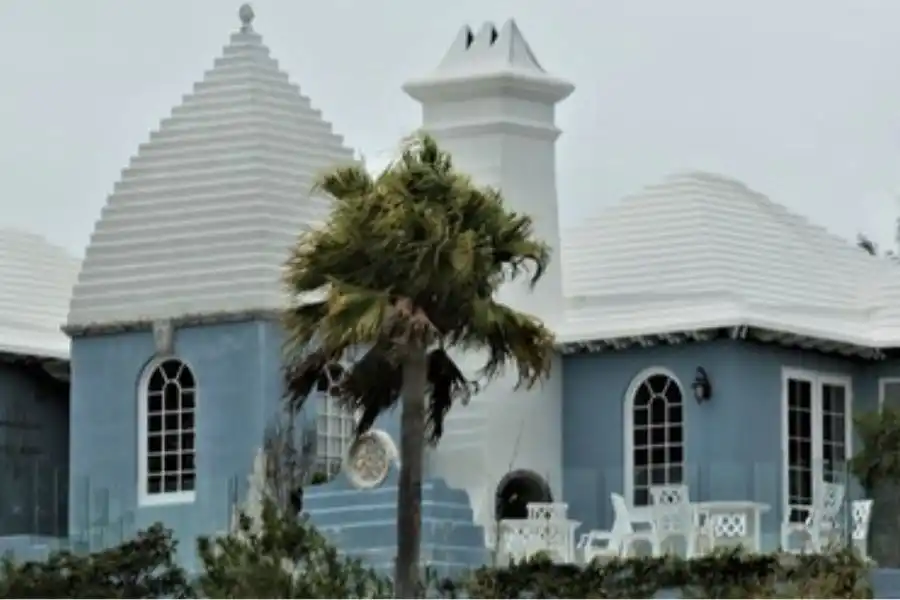The architecture of Bermuda Homes is an intriguing collage of classic and contemporary forms, influenced by the island’s special mix of history and nature. From the pastel shades that paint their walls and signature white limestone roofs, Bermuda’s homes aren’t just visually stunning — they’re also expertly crafted to tolerate year-round subtropical conditions with an occasional hurricane or two.
In this article, we delve into the bountiful architectural heritage of Bermuda homes – exploring unique characteristics and aspects of historical development that imbue Bermudian architecture with various cultural values.
Key Takeaways:
- Bermuda homes are renowned for their pastel colors and limestone roofs.
- The architecture is a practical response to the island’s climate and weather conditions.
- Influences include British colonial design and adaptations for local needs.
- These homes are a symbol of Bermuda’s cultural and historical identity.
Historical Evolution of Bermuda Homes
The architecture of Bermuda homes has experienced remarkable changes since the island’s initial payment in the early 17th century. When the first European settlers came, they constructed rudimentary wooden frames, reflecting the architectural techniques and materials familiar to them from their lands. These early homes were simplistic in design, often consisting of a plain wooden frame and thatched roofs.
However, the subtropical weather and the routine, intense storms quickly revealed the inadequacies of these initial structures. The wood and thatch could not resist the high winds and weighty rains, leading to regular damage and the need for regular repairs.
Early Structures
- Wooden Frames: Early Bermudian homes were constructed with wooden frames and thatched roofs, which proved inadequate against hurricanes.
- Stone Construction: By the mid-17th century, settlers began using local limestone, a more durable material that could withstand strong winds and heavy rains.
Colonial Influences
- British Colonial Design: The architecture of Bermuda homes was heavily influenced by British colonial styles, incorporating features like symmetrical facades and sash windows.
- Adaptations for Local Needs: Over time, Bermudians adapted these designs to suit their local environment, leading to the development of distinctive architectural features.
Preservation of Heritage
- Historical Preservation: Many of Bermuda’s historic homes have been preserved and restored, maintaining the island’s architectural heritage.
- Cultural Significance: These homes are not just buildings but symbols of Bermuda’s rich cultural history.
Distinctive Features of Bermuda Homes
The distinct architectural style and practicality have made Bermudian homes easy to spot. It is through these unique features that, not only does the island boast almost storybook charm in its landscaping but also holds practical reasoning due to Bermuda’s subtropical style of weather and geographic location.
Limestone Roofs
- Rainwater Collection: The white limestone roofs are designed to collect rainwater, which is stored in cisterns below the house.
- Heat Reflection: The white color helps reflect the sun’s heat, keeping the homes cooler in the subtropical climate.
Pastel Colors
- Visual Appeal: The pastel-colored exteriors, ranging from soft pinks to light blues and greens, add to the island’s charm.
- Historical Roots: This tradition dates back to the 19th century and has become a hallmark of Bermudian architecture.
Chimneys and Fireplaces
- Practical Use: Historically, chimneys and fireplaces were essential for cooking and heating.
- Aesthetic Value: Today, they are valued for their aesthetic contribution to the homes’ design.
The Role of Climate in Bermudian Architecture
Home architecture in Bermuda is influenced by the hot, humid summers and frequent hurricanes experienced on the island. This special climate has conditioned the architecture and construction of Bermuda homes to be environmentally responsive for centuries, resulting in buildings that provide natural comfort and are quite resilient.
Hurricane Resistance
- Sturdy Construction: Bermuda homes are built with thick walls and low, steeply pitched roofs to withstand strong winds.
- Shuttered Windows: Shutters protect windows from flying debris during storms.
Ventilation and Cooling
- High Ceilings: High ceilings allow hot air to rise, keeping the living spaces cooler.
- Louvered Windows: These windows enable cross-ventilation, promoting airflow and cooling the interiors naturally.
Cultural and Social Significance
For Bermudians, Bermuda homes are more than just buildings; they have rich cultural and social importance. Unique to Bermuda, these homes symbolize the country’s identity and ideals as a community; they are irreplaceable remnants of Bermuda-fashioned history itself. They facilitate a concrete connection from past to present, which in turn keeps Bermuda as a whole and living.
Community Identity
- Symbol of Heritage: These homes symbolize Bermuda’s historical and cultural identity, connecting present-day Bermudians with their past.
- Cultural Events: Many cultural events and festivals in Bermuda are centered around historic homes and neighborhoods.
Tourism Attraction
- Architectural Tours: The unique architecture of Bermuda homes attracts tourists, contributing to the island’s economy.
- Film and Photography: The picturesque homes are often featured in films and photography, showcasing Bermuda’s beauty to the world.
Modern Adaptations and Innovations
Each of the old Bermuda homes still displays its traditional charm, though they have been adapted and revised to function for the modern day. The preservation modifications aim to allow the homes to function as both repositories of history and sources of comfort in response to shifting lifestyles and climate, while also safeguarding their unique historical and architectural character.
Sustainable Practices
- Green Building Techniques: Modern Bermudian homes often incorporate sustainable building techniques, such as solar panels and energy-efficient materials.
- Water Conservation: The traditional rainwater collection system is complemented by modern water-saving technologies.
Interior Design
- Blending Old and New: Interiors often blend traditional elements, like exposed beams and wooden floors, with modern conveniences.
- Open Plan Living: Modern Bermuda homes favor open-plan living spaces, enhancing functionality and comfort.
Architectural Case Studies
Examining specific examples of Bermuda homes provides deeper insights into their design and significance.
Tucker House Museum
- Historical Landmark: Located in St. George’s, the Tucker House Museum is a well-preserved example of early Bermudian architecture.
- Educational Resource: It serves as an educational resource, offering insights into the island’s colonial history.
Bermuda National Trust Homes
- Heritage Preservation: The Bermuda National Trust manages several historic homes, ensuring their preservation and public accessibility.
- Architectural Tours: These homes are part of guided tours, educating visitors about Bermudian architectural heritage.
Challenges and Future of Bermuda Architecture
The architecture of Bermuda homes faces challenges, but also opportunities for future development.
Environmental Challenges
- Climate Change: Rising sea levels and increased hurricane activity pose threats to Bermuda homes.
- Preservation Efforts: Efforts are underway to preserve and protect these historic structures from environmental damage.
Future Directions
- Innovative Design: Architects are exploring innovative designs that blend tradition with modern sustainability.
- Community Involvement: Engaging the local community in preservation and adaptation efforts is crucial for the future of Bermuda’s architectural heritage.
People Also Ask
What materials are commonly used in Bermuda homes?
Bermuda homes are primarily built with limestone and wood, with limestone being used for roofs and walls due to its durability and water-collecting properties.
Why are Bermuda homes painted in pastel colors?
The tradition of painting homes in pastel colors dates back to the 19th century and is a distinctive feature that adds to the island’s charm and aesthetic appeal.
How do Bermuda homes manage water supply?
The white limestone roofs are designed to collect rainwater, which is then stored in underground cisterns, providing a sustainable water supply.
Are Bermuda homes designed to withstand hurricanes?
Yes, Bermuda homes are built with thick walls, low, steeply pitched roofs, and shuttered windows to withstand strong winds and protect against hurricanes.
What are some modern adaptations in Bermuda home architecture?
Modern adaptations include sustainable building techniques, energy-efficient materials, and the blending of traditional elements with contemporary interior design.
Conclusion
Beautiful architecture, the history of Bermuda Homes reflects a cultural blend and an enterprising spirit that’s perfectly in harmony with island life. Their pastel colors and white limestone roofs, accompanied by practical features for the natural surroundings, symbolize a blend of old and new that you can only find in Bermuda.
With Bermuda currently under threat and constant evolution with environmental changes, maintenance of the island’s architectural legacy has never been more important. So, what interests you most about Bermuda home architecture? Go further for more stories of Bermuda and its culture & architecture.

